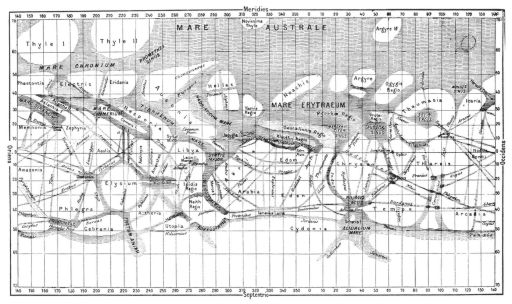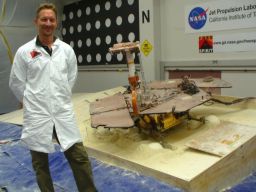A.J.S. Rayl • Jun 17, 2010
Mars Exploration Rovers Update: Spirit Team Announces Major Water Discovery
Mars Exploration Rover Spirit continued to hibernate this month, parked in place near an old volcanic formation called Home Plate. At the same time though she managed to rove back into the planetary exploration spotlight when a group of the mission scientists announced they had found -- in data from an outcrop the rover visited more than four years ago -- evidence for a past watery environment more suitable for life than any other either Spirit or Opportunity have found, a place where near-pure water existed. 1
Spirit came across the strange looking outcrop, called Comanche, in December 2005, while hiking down from Husband Hill and into the Inner Basin, where Home Plate had captured the rover's eyes and the team's attention. The outcrop looked weird enough that it drew them in, and the team commanded the rover to make a pit stop to examine it up-close with all its instruments. That was in December 2005.
Spirit and the mission moved on. But for senior planetary scientist Dick Morris, manager of the Spectroscopy and Magnetics Laboratory down on Earth at NASA's Johnson Space Center (JSC), the work on Spirit’s latest bizarre taget was only beginning. He knew from his first look at data from the Mössbauer spectrometer, an instrument that detects iron-bearing minerals, something was different. It would take him a couple of years before he openly hazarded his guess and that was but a new beginning.
Ultimately, it would take Morris’ continued persistence inside and outside the laboratory and cajoling a number of other scientists on the MER team to sign up to conducting analyses, and even then, more testing to unequivocally confirm his hunch. But it paid off big time. Comanche is harboring magnesium iron carbonate -- and a lot of it. And that’s a discovery that MER Principal Investigator Steve Squyres is now calling “one of the top five findings of the entire mission.” The team’s report was published in Science online June 3, 2010.
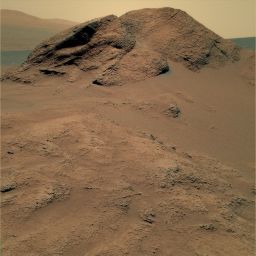 Comanche in Martian color
Comanche in Martian colorComanche just looked different. The scientists generally believe it's the remnant of something larger, "perhaps a volcano or bed of volcanoes," says Ray Arvidson, MER deputy principal investigator and a co-author of the paper.
Credit: NASA / JPL-Caltech / Cornell / colorized by Stuart Atkinson
To understand the scientific excitement surrounding this, you have to understand that carbonate is a very big deal among planetary scientists and has been at least since the 1970s. That’s because it is, in essence, evidence for a Martian past when water flowed and life as we know it could have taken hold. Carbonate typically precipitates from water and dissolves quite easily in acid; therefore, rocks on the surface of Mars that have high amounts of carbonate would indicate they have not been exposed to much acid but have evolved in water conditions with a pH welcoming, even nourishing of life.
Although many scientists have long believed that Mars was once warmer and wetter with an atmosphere rich in carbon dioxide (CO2) and that carbonates should be abundant on the planet, the mineral has been uncannily elusive. There have been some Martian meteorites bearing carbonate but not much, and certainly Spirit's discovery of carbonate wasn't just there for the taking. "We used detective work combining results from three spectrometers to lock this down,” said Morris, lead author of the report. It was a long and often painstaking process. But, “the instruments gave us multiple, interlocking ways of confirming the magnesium iron carbonate, with a good handle on how much there is,” he said. And Comanche opened a distinctive doorway into the Columbia Hills of eons past.
Granted, both Spirit and Opportunity found evidence for past watery conditions suitable for life a long time ago, more than six years ago actually during their primary, 90-day mission. But Comanche represents something different. “All of the other evidence that we have found for water on this mission so far, at both landing sites, has at least been consistent with that water being very acidic, low pH," noted Squyres, a coauthor of the paper.
The term pH -- a scientific acronym where the “p” stands for potential and the “H” stands for Hydrogen -- as an indicator or measurement for acidity or alkalinity. A pH value of 7, for example, means a substance is neutral, with lower values indicating acidity, and higher values alkalinity. The pH of pure water is 7 or neutral. The normal range for pH in surface water systems on Earth is estimated to be from 6.5 to 8.5, and for groundwater systems 6 to 8.5.
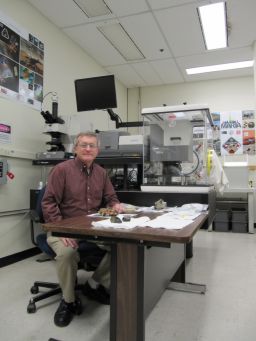 Dick Morris
Dick MorrisDick Morris is a senior planetary scientist and manager of the Spectroscopy and Magnetics Laboratory down on Earth at NASA's Johnson Space Center (JSC) where he is in this picture. By all accounts, it was Morris' persistence that led to the MER team's discovery if carbonates on Mars.
Credit: NASA / JSC
Even though scientists know that life can evolve to survive in many extreme conditions, getting life to emerge, to begin in low pH conditions is "probably very, very hard," Squyres acknowledged. Now, however, the past conditions that Spirit stumbled on in Comanche, the "near-neutral water,” as Morris defines it, provided watery conditions more favorable for life than anything else found by either rover at either site "because of the neutral pH,” Squyres stressed. "The important thing here is that the presence of carbonates points to more neutral chemistry and that is pointing to chemistry that would be more favorable for life."
It also seems there was enough of it. Comanche boasts a 10-fold higher concentration of carbonate than in any previous carbonate-bearing Martian rock, "There have been detections of carbonate before, but never this much in terms of percentage or abundance," Morris pointed out. "We have clear and compelling evidence now for watery conditions in the past at Gusev Crater with a neutral pH,” Squyres declared.
It is a major finding, for Spirit, the individual scientists, the mission, and for Mars exploration. While the news of the discovery was duly reported, the story seemed to come and go without much media fanfare. Perhaps that's because most people have tired of announcements of environments where life may have emerged. Perhaps we are at a point when only the discovery of alien life could distract people from today’s economic woes or ‘oil-in-the-Gulf’ headlines or latest Congressional act of debauchery.
"People hear 'neutral pH and their eyes glaze over," Squyres acknowledged. "You do have to go one level deeper in your understanding of this problem to recognize how important pH is before you really clue in to the true significance of this discovery."
That one level deeper is, however, where all the action is. Locked inside Comanche is the story of a different time, a different place, where volcanoes were erupting, steam vents were venting, and hot springs bubbling, and somewhere in the mix, “near neutral water” was offering up a haven for life.
In order to get from Spirit’s current desert-like environs to a warmer-wetter Mars back when, Morris had to make a concerted effort to convince the necessary team members that it was worth their time and energy to help him unlock the secrets left behind in Comanche.
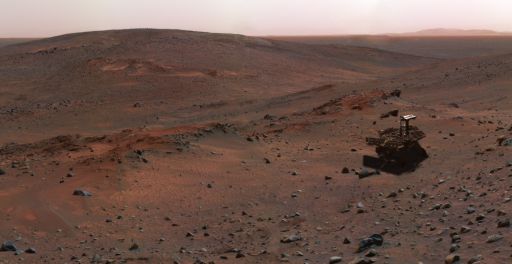 Simulation of Spirit on the flank of Husband Hill
Simulation of Spirit on the flank of Husband HillTo create this image, a computer simulation of Spirit was dropped into a Pancam panorama captured on the flank of Husband Hill on Spirit's Sol 454 (Apr. 13, 2005). The image is available in a poster-sized rendering at JPL's website (25 MB).Credit: NASA / JPL-Caltech; Rover model by Dan Maas; synthetic image by Koji Kuramura, Zareh Gorjian, Mike Stetson and Eric M. De Jong
For a century and a half, at least since Giovanni Schiaparelli stared through his telescope and saw channels cutting through the landscape of Mars, like rivers and canyons cut through the landscapes of Earth, we’ve had reason to believe that Mars was once warmer and wetter, and more like Earth. The planet, it was assumed for a good long while, was probably home to beings like us, Martian people.
Decades of research and the lack of any Wellsian spacecraft hovering over New Jersey annihilated any hope/fear of Martian people. But the belief that Mars was once more like Earth -- though both threatened and bolstered by scientific findings over the years -- has lived on.
For starters, Mars is in the zone of habitability, the region in a star-centered orbit where an Earth-like planet can maintain liquid water on its surface. If liquid water did once flow across and percolate up from Mars' now rusty red surface, then the planet at that time likely had a dense atmosphere, probably rich in carbon dioxide (CO2) given the prevalence of that gas. This kind of atmosphere, like Earth's, would have created a so-called 'greenhouse warming' effect and that is what would have enabled the water to flow.
If Mars was once warmer and wetter, then the geologic record should show that, using Earth as an analogue. On Earth, the CO2 emerges, evolves, and circulates. "The weather cycle takes the CO2 and locks it into carbonate and then the tectonics cycle and plate tectonics bring carbonates back down into seduction zones and releases the CO2, so there's this battle between weathering and tectonicism," explained Ray Arvidson, deputy p.i., and a co-author of the paper "If you work backward to a point of having more CO2in the Martian atmosphere, you can get greenhouse heating where you have rainfall run-off, and then the CO2 absorption by the water to make carbonate rocks, and then, because the CO2 is sequestered, Mars goes into the deep freeze."
Today, because of Mars' current very thin atmosphere, water would not 'survive' on the surface for long. It would either freeze or sublimate away. Since Mars certainly appears to be in that deep freeze, what happened to all the CO2?
The missing CO2 is something scientists have debated over the years. Some believe the bulk of the CO2 slipped into space; others hypothesize, pertinent to this story, that it left the atmosphere by the mixing of carbon dioxide with water under conditions that led to forming carbonate minerals. Carbonate forms actually when CO2 gas dissolves in water releasing negatively charged carbonate ions (anions, CO32-) that in turn bind to various positively charged ions or cations, such as calcium or magnesium.
 Steve Squyres
Steve SquyresMER Principal Investigator Steve Squyres talks with a few hundred of the 4000+ people who contributed to the Mars Exploration Rover mission, at the MER 5th Anniversary Celebration, held Jan. 15, 2009 at JPL. Squyres is the Goldwin Smith Professor of Astronomy at Cornell University.Credit: NASA / JPL-Caltech
By the 1990s, discoveries of small amounts of carbonate in meteorites that originated from Mars bolstered the carbonate notion and boosted expectations that the mineral would be abundant on Mars. Carbonate rocks would be the ‘smoking gun’ evidence for the warmer-wetter hypothesis … except carbonate-rich rocks seemed nowhere to be found.
Scientists determined decades ago that the "ice caps" at Mars' north/south poles are primarily CO2, very much unlike Earth's Arctic and Antarctica, but it's not enough to account for all of the presumed CO2 lost when Mars' atmosphere changed. Thus there must be more, a lot more carbonate hiding somewhere on the planet. "It's kind of missing relative to the massive sedimentary rock record of sulfates,” noted Arvidson who’s been exploring Mars since Viking in the 1970s. "Everyone has been consistently surprised it's been so difficult to find a carbonate rock record on Mars."
While Christensen’s team did find trace amounts of carbonates to be widely distributed in the silicate-rich dust analyzed from 21 bright, dusty surfaces on Mars located between 30-degrees S and 15-degrees N, it found no evidence in that data for widespread deposits of exposed carbonate rock. These findings would seem much more consistent with the idea that Mars has long been cold and mostly dry, rather than warm and wet with a thick carbon dioxide atmosphere.
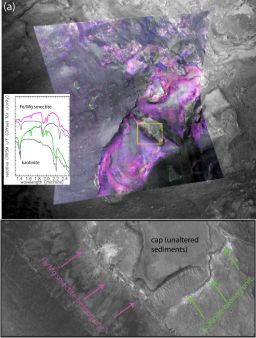
Carbontes at Nili Fossae
This image shows an outcrop within the center of an unnamed 40-kilometer-diameter crater within Nili Fossae. The base map is a context camera image. Superimposed on that is a mineral map derived from CRISM infrared spectra. The inset shows spectra for two minerals observed in the CRISM data: smectite, a clay mineral containing iron and magnesium (magenta line and magenta areas on map) and kaolinite, a clay mineral that does not contain iron or magnesium (green line and green areas on mineral map). Examination of the relationship between the CRISM mineral map and the base CTX image shows that most of the thick sedimentary units filling the crater contain smectite (magenta), but they are overlain by a distinct, bright-toned kaolinite-bearing material (green). Both have been exposed from beneath a capping unit (purple) by erosion of the deposits from the action of liquid water. Credit: NASA / JPL-Caltech / University of Arizona
Closely associated with both phyllosilicate-bearing and olivine-rich rock units, the carbonate probably formed during the Noachian or early Hesperian era from the alteration of olivine by either hydrothermal fluids or near-surface water.
Ehlmann, et al.,'s findings of the presence of carbonate and the accompanying clays suggest that “waters were neutral to alkaline at the time of its formation and that acidic weathering, proposed to be characteristic of Hesperian Mars, did not destroy these carbonates thus did not dominate all aqueous environments," as they wrote in their paper published in Science. 3
Chance, as Louis Pasteur put it, favors the prepared mind, and in this case, the prepared rover. Back around Christmas time in 2005, Spirit was still descending from the top of Husband Hill to Home Plate plateau in the Inner Basin that spreads out from the Columbia Hills at Gusev Crater Mars. The rover was taking her time and being careful in the hike down, stopping here and there to inspect rock outcrops.
One in particular looked distinctly different. It was layered and featured particlates and most of the scientists thought it was likely an erosional remnant of a larger landform, "maybe another volcano or bed of volcanoes," specified Arvidson. The scientists dubbed it Comanche, had Spirit check it out up close, to determine its composition.
From the captain’s log December 2005: Like everything else we've seen since we've descended off of Haskin Ridge, Comanche Spur has undergone very little alteration and has a lot of olivine in it, Squyres wrote. But the composition is different from what we saw at Seminole and Algonquin, so we seem to have yet another rock type at Gusev.
Dick Morris continued his analyses on the data Spirit collected with the Mössbauer spectrometer and eventually realized that Comanche’s difference extended to its composition. "He knew right away there was something odd-looking in the Mössbauer data," remembered Arvidson.
"When we analyzed the Mössbauer data back in 2005, we noticed that it had two doublets," recalled Morris These spectrum lines, he said, were "due to two different iron-bearing phases: one was for olivine, which we see everywhere, and another doublet was normally assigned to a pyroxene." But the parameters of what he was seeing were different from pyroxene. "We just didn't really know at the time," he said.
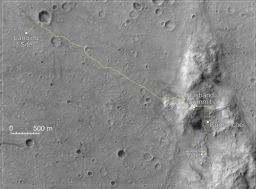 Orbital view of Comanche
Orbital view of ComancheSpirit began its Mars exploration at its landing site in January 2004. As of early June 2010, the rover has been at a sand-trap location called Troy for more than a year, next to the western edge of a low plateau, Home Plate. In Dec. 2005, Spirit inspected an outcrop called Comanche during its descent from the summit of Husband Hill toward Home Plate. Lengthy detective work using data that Spirit collected with its three spectrometers yielded a June 2010 report that Comanche contains a high concentration of carbonate, indicating that a past environment at this location was wet and non-acidic, possibly favorable to life. The locations of the landing site, Husband summit, Comanche and Troy, along a yellow line tracing Spirit's route, are shown here on a portion of an image taken by the High Resolution Imaging Science Experiment on NASA's Mars Reconnaissance Orbiter on Nov. 22, 2006. North is up.Credit: NASA / JPL-Caltech / UA
The mission and Morris’ work continued. By February 2008 his hunch was turning into a theory when he realized that the parameters for iron-bearing carbonates were similar to what Spirit found for Comanche. “That's when I had it in my mind that carbonate was a definite possibly here,” Morris recalled. But his theory and strange spectra needed solid corroboration, and that was going to take some time.
A discovery of carbonate would be a big deal, and so the analyses had to be spot on. “He was detecting iron carbonates and wanted to make sure that was the case,” Arvidson said. "Dick Morris is a very careful kind of guy."
"While we initially chalked it up to some kind of pyroxene we hadn't seen before, Dick really dug in, worked it hard, and he came to the conclusion, and kept coming to the conclusion that what it really looked like was iron carbonate,” remembered Squyres.
Since the Mössbauer is designed to detect iron-bearing minerals, it can 'see' iron-bearing carbonate, but it can not see magnesium carbonate, for example, or calcium carbonate; therefore, the data Spirit recorded with other instruments would have to be reviewed and analyzed if the presence of carbonate was to be definitively shown.
"On MER, we like to have the instruments that are sensitive to mineralogy and chemistry agree with each other or explain why they don't," Morris explained. "So my job on this at that point was in pursuing Ralf Gellert [of the University of Guelph in Ontario, Canada] to run calculations on the alpha particle X-ray spectrometer (APXS) data, then convincing Steve Ruff, of Arizona State University (ASU], to look back on the data Spirit took with the miniature thermal emission spectrometer (Mini-TES). We needed to convince everybody to look at it hard to settle this one way or another."
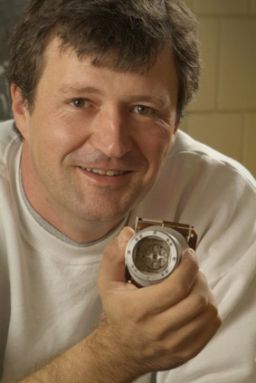 Ralf Gellert
Ralf GellertRalf Gellert, assistant professor at the University of Guelph in Canada, is the lead scientist for the alpha particle X-ray spectrometer (APXS) on Spirit and Opportunity.
Credit: University of Guelph
Clearly, the potential for carbonate was worth settling. Morris decided to go after Gellert first. The APXS can detect high concentrations of light elements, such as carbon, nitrogen, and oxygen. If these elements were present in excess, then that would help quantify the carbonate content by process of deduction.
"The way you get at the light elements with the APXS is to figure out what all the cations are that you measure that can connect with the oxygen, and if there's left-over oxygen there has to be a light element you can't see, like carbon," explained Arvidson.
Gellert and his team ran calculations on the data taken at Comanche Spur, as well as on a target at a nearby rock that was also olivine rich, Algonquin.
“It must have been beginning of 2007 when we first discussed this,” Gellert said. “At that time we saw in the APXS data that Comanche is different from Algonquin, but we couldn't really quantify it. I was skeptical [of carbonate] from the beginning. Having done Mössbauer myself a long time ago, I thought the slight difference of the carbonates to the pyroxene in the Mössbauer parameter might have been an artifact from the Mössbauer drive or not statistically sound. The method for excess light elements was then later improved and better investigated, and Dick got better numbers from us.” Even so, the APXS numbers still have “quite some large” error bars, he said. " “But it was another sign (beside the slightly different Mössbauer parameters) that kept Dick suspecting that something's up with the Comanche outcrop."
In January 2009, Gellert delivered his team’s summary findings during the MER science team's 2009 team meeting at Caltech. They found Algonquin to be dry, meaning it features no excess light elements, Gellert reported. Comanche Spur, however, did show excess light elements. It was a good solid second step for Morris. “The APXS data were permissive for carbonate,” he recounted.
Actually, as Morris viewed it, Gellert’s analysis, the "second piece" of the story, was truly telling. "Once the APXS results were in, I had pretty much convinced myself in my own mind that this was definitely carbonate,” Morris said. “At that point, I knew we were on to something pretty good. But the APXS is limited in that it cannot identify light elements, only whether there is an excess presence; therefore, these analyses didn’t offer any kind of conclusive conclusion on the presence of carbonate.
Closing in unequivocally on Morris’ carbonate theory would require more analysis. The miniature thermal emission spectrometer (Mini-TES) has the best capability for detecting carbonates and the data Spirit collected from it had to hold the answer. Once again, Morris approached Ruff, who has been overseeing the science on Spirit’s Mini-TES almost from the beginning as P.I. Phil Christensen turned his attentions to Opportunity's Mini-TES, and now focuses on THEMIS on Mars Odyssey.
Morris had "bugged" Ruff several times over the years. Looking back, Morris chuckled. "He wasn't really buying into this."
Ruff, another co-author of the report, doesn’t argue that at all. "Dick was definitely onto it being carbonate, and I did go back a couple of times, and I remember dabbling with the data, but I just didn't see it," Ruff recalled during an interview this week.
There was good reason for that actually. A mirror on the Mini-TES had been contaminated with dust months earlier during the first real wind event the MER mission experienced. That same wind gust also proved to be a real saving grace as it blew off accumulated dust from the rover's solar panels. Over a two-sol period, Spirit was revitalized with "new life." It was a first lesson-learned in the give-and-take of Mars. “The dust clearing event for the solar arrays was a dust obscuring event for Mini-TES,” Ruff remembered. Although the Mini-TES still worked, it was rather like "looking through dirty glasses," admitted Ruff, who had almost gotten used to the infringed view. He could tell there was something very different about Comanche compared with other outcrops Spirit had seen. “But we couldn't tell what it was, and I wasn't convinced it was carbonate,” he said.
"Since the Mini-TES had dust in its eye, so to speak, Steve went to work on getting the dust correction tweaked," Morris said, continuing the story.
“Getting the dust-correction algorithm working for us was a process that developed over time,” added Ruff. "There's a lot of variability among the Mini-TES targets: surface dust accumulated on the rocks can really obscure the substrate; temperatures vary, which is a function of time and day; and the mass of thermal inertia of these rocks is high, so we were mostly seeing cold temps, which gives us low signal-to-noise and makes it harder to interpret the data,” he explained.
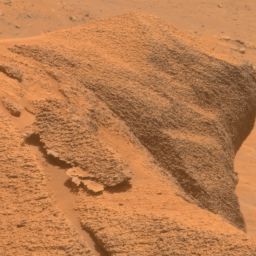 Saupitty
SaupittySpirit took this image of Saupitty, part of the Comanche outcrop, in December 2005. This section, the mass seen here, was named for a Comanche code-talker who transmitted information for the Allies during World War II. Now this rock is talking, in geologic code. When Spirit looked at Saupitty with its Mini-TES, the spectra it recorded clearly showed carbonate.Credit: NASA / JPL / Cornell University
One of the other Mini-TES scientists, Michael D. (Mike) Smith, of NASA Goddard, with the atmospheric science group, developed a dust-correction algorithm in 2006, but it wasn’t until mid-2007 that the surface operations group started to look at using it for their work, Ruff said. "Sometimes these things are just a matter of getting a conveniently useable algorithm coded up in a tool that others can use easily.”
Amy Knudsen, Ruff's counterpart for Opportunity's now dust-blinded Mini-TES, came to that rescue. “She took Mike's algorithm , which was in some software that the surface crew didn't use, acoded it up into a software package that we have, and made it easy for us to use." It offered a whole new view.
When Ruff applied Smith’s algorithm as revised by Knudsen to the Mini-TES data from Comanche, lo and behold. "Everything pretty much fell into place,” said Morris “The three carbonate fundamentals popped out nicely, completing the story."
Among the dozen of so Mini-TES targets at the Comanche outcrop, one really stood out, Ruff remembered. "Saupitty really showed spectral features the clearest,” he said. “This target had the right combination for Mini-TES, relatively low dust and relatively high temperature. With that combination and dust correction, suddenly it really became quite clear that indeed there's a whole bunch of carbonate in these rocks,” Ruff recounted. “Dick was clued in early and persistent enough to stay with it and to push me to get back to it. But seeing the spectra, that’s when I became excited.”
[Ed. Note: Saupitty was named for Comanche code-talker Larry Saupitty, who transmitted vital data to Allied troops during World War II. It was keeping in line with the Native American tribe naming theme chosen for Spirit’s descent down Husband Hill.]
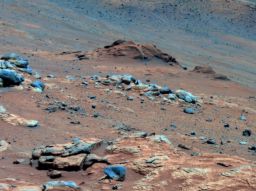 Comanche in false color
Comanche in false colorIn this false color image, Comanche is the dark reddish mound above the center of the view. The false color makes some differences in materials easier to see. The main Comanche outcrop is about 5 meters (16 feet) from left to right from this perspective. The paler material visible at bottom right is part of another nearby outcrop called Algonquin.
Credit: NASA / JPL-Caltech / Cornell
The Athena science ‘tool-kit’ that the rovers carry was designed so the instruments could function independently and interact, to back-up hypothesis or exclude errant notions. During this research, the value of the tool-kit’s design was obvious. Each of Spirit’s instruments, particularly the spectrometers, served an integrated purpose, adding critical pieces of the puzzle, creating a sum greater than the parts.
"When we put it all together, we had a really consistent story told by all three of our spectrometers, rather than just a Mössbauer signal that shows a funny mineral that might be iron carbonates," said Squyres. "It really was a nice bit of detective work. We knew then we had a story to tell."
“This wasn't a straightforward 'a-ha,' but something that germinated and grew over a long time,” said Morris. “Science is a lot of detective work and as a part of this we did have to do some laboratory studies too. But in any discovery like this you really do need to have multiple ways of confirming what you've got, and the way the APXS and the Mössbauer and the Mini-TES worked together was spectacular here.”
Although some media stories reported that Spirit's recent findings confirm the warmer- wetter theory for once and all, the rover’s discovery of carbonate "doesn't speak to Mars being any warmer and wetter than our other evidence for warm and wet conditions does," Squyres corrected. "Keep in mind this is a single outcrop only meters in size. One cannot look at this outcrop and say, 'A-ha there must have been a dense CO2 atmosphere on Mars in the past.' The story here is consistent with that story, but it by no means proves it. This is a very small outcrop, the only discovery of carbonates like this that's ever been made. You can't hide all the CO2 once in the Martian atmosphere in this outcrop. This finding does prove watery conditions with a neutral pH," he underscored. "The important thing here is neutral pH, the chemistry of the water."
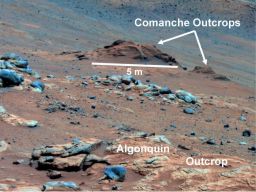 Comanche territory
Comanche territoryLengthy detective work with data that Spirit collected in late 2005 has confirmed that an outcrop called Comanche contains carbonate, a mineral indicating that a past environment was wet and non-acidic, possibly favorable to life. The rover used its panoramic camera to capture this view of the outcrop during its Sol 689 (Dec. 11, 2005). Spirit used its Mössbauer spectrometer, Mini-TES, and APXS to examine targets on the Comanche outcrop. Four and a half years later, on June 3, 2010, scientists using data from all three spectrometers reported the big discovery: about one-fourth of the composition of Comanche is magnesium iron carbonate. That concentration is 10 times higher than for any previously identified carbonate in a Martian rock.
Credit: NASA / JPL-Caltech / Cornell
And of course the potential for better living through that chemistry since the presence of carbonates kicks the prospects of past life up a few important notches … although no one is claiming an ocean or even a sea teeming with life where Spirit is parked.
Back when it was being decided where the rovers would land, Gusev Crater was chosen because in part of a long-held notion that it once held a body of water, a lake or small sea. “This discovery has nothing to do with the lake that we once believed existed within Gusev Crater. Spirit has never found lakebed deposits and certainly never will. This is something different,” said Squyres. “The Columbia Hills are a place we've seen lots of evidence for hydrothermal activity and that makes us think that these Comanche carbonates were probably hydrothermal deposited as well.”
This is where this detective story twists. As Arvidson so succinctly put it: “You don't need a dense atmosphere to do what we see here.”
We don't really know what the Columbia Hills area would have looked like way back when, only that it did look different. Spirit might well have been be parked amidst the shock and awe of geologic action as Mars evolved. "There would be spewing volcanoes, active eruptions, steam vents, and in this case not a lot of sulfur but a lot of carbon dioxide,” suggested Arvidson.
“This represents a particular period, maybe prior to the acid-sulfate-enriched systems, an earlier period when there was more CO2 either in the atmosphere or coming up from the gases and magma, as in CO2 rich fluids coming up through the ground, filling in cracks, and permeating through the granular material that makes up Comanche," Arvidson continued. "It could be a local phenomenon, with just CO2 enriched fluids, or it could be a marker or piece of evidence that there was a CO2 rich atmosphere early on. We don't know," said Arvidson. Either way, these carbonate-rich rocks would have formed.
"What Spirit's location at the Comanche outcrop looked like all those millennia ago will be worked on and debated by a lot of people for a lot of years,” Morris concluded. "All I would say at this point is that the Comanche Spur type material was a whole lot bigger than it is now. It looks like an aeolian remnant that has been worn down by time.”
 Ray Arvidson
Ray ArvidsonMER Deputy Principal Investigator Ray Arvidson is the James S. McDonnell Distinguished University Professor at Washington University St. Louis. He has been exploring the geology of Mars since Viking, when he served as the the Viking Lander Imaging Team leader from 1977 to 1982.
Credit: A.J.S. Rayl / The Planetary Society
As with most scientific discoveries, this one leads to more questions than answers, and so the mystery has deepened. One intriguing aspect to this story that's worth pondering is the fact that the composition of the Comanche carbonate is very close to the composition of the carbonate in the Martian meteorite ALH84001, which was found in Antarctica in the 1980s, and became famous in August 1996 when NASA scientist David McKay, now chief scientist for astrobiology at JSC, claimed it harbored traces of past Martian life. 5
"The carbonate was one of the lines of evidence that McKay et al., used to say this was a rock that had seen habitable conditions," Squyres pointed out. "We're making that same argument."
Unlike ALH84001, the MER results "do not bear on whether there was life there or not, just that the conditions were," reminded both Morris and Squyres. "The question about the similarity is whether or not it's coincidence," Arvidson added.
"We've got at least the Comanche carbonate and the Nili Fossae carbonate and the place wherever ALH84001 came from, three locations with plus-minus the same kind of carbonate," offered Morris. "Maybe Mars is trying to tell us something about the way carbonates occur on the surface."
Time, as always, will tell. For now, Spirit and this group of scientists have uncovered evidence, ground truth that there is carbonate stored in rocks on Mars. A hunch formulated into a theory and a long-sought mineral was brought home -- and with it one of the mission’s most important discoveries was made. Morris and his co-authors have every right to take a moment to bask in the joy of that discovery, because at the end of the sol, finding carbonates on Mars is a major accomplishment.
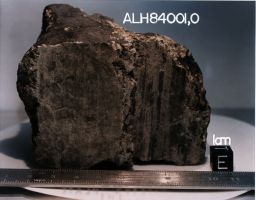 Martian meteorite ALH84001
Martian meteorite ALH84001Discovered in Antarctica in 1984, Allan Hills 84001 was not identified as a Mars meteorite until 1994, when it was also discovered to contain carbonate minerals. In 1996, an article published in Science by David McKay et al., suggested "possible relic biogenic activity," or traces of past life in the meteorite. Credit: NASA / JSC
"It certainly it gives you another data point from which to build your models and speculate on how much is there," reflected Morris. "There will be lots of mapping on how big this Comanche carbonate occurrence is now and how big it might have been in times past, but however big it was, this is additional evidence that conditions that were favorable for life did exist a long time ago on Mars,” he reiterated.
"The three instruments were in deadlock on all this and not only in deadlock on the basic composition of the carbonate, but also how much was there," marveled Morris. "The Mössbauer and APXS together indicated 16-34% of carbonate in the rock and Mini-TES was in the middle 30s too, so there was good agreement in more than one way that this was carbonate and how much was there," he said, pausing. "It was a cool thing. Totally cool. It was just a really great detective story.”
Seriously, does science get any better?
"Okay," Morris relented, "it was awesome. Although," he added, pausing, "if all the world were Mössbauer people, it wouldn't have taken this long."
Ruff takes the jibe graciously. "The Mini-TES science analysis has been limited to one or two people on the Spirit side, so sure, having more eyeballs and brains looking at data things would have been clearer earlier probably, so I can't really discount that,” he admitted. “But it was the delay almost that makes it more fun, and to realize that there are these hidden discoveries in the datasets still waiting to be made,” he rationalized with a believable authenticity.
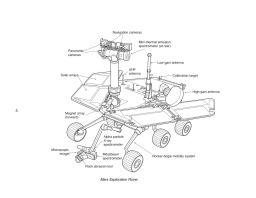 MER
MERThis diagram shows the basic layout of the Mars Exploration Rovers suite of scientific instruments. Credit: NASA /JPL-Caltech / Cornell
The ink on their report is barely cool, but the MER scientists have already been thinking about the lessons learned and the implications.
"It tells me that if we want to look for life, it's going to have be sub-surface," Arvidson offered. “Or find places where Nature has dug for us.”
“I see this story from two points of view,” reflected Gellert. “First of all, there were carbonates on Mars, despite all the evidence for acidic water alteration. Now it's the question, how much was formed and when, plus how much was possibly destroyed by acidic brine afterward,” he said.
“Secondly, from a more APXS-centered position, it gives me some kind of confirmation of the importance of the APXS in the big picture,” Gellert continued. Mineralogy is the holy grail of planetology, however the signatures of some minerals are not always that unambiguous, like here with carbonates. Elemental chemistry with the APXS is bread and butter geology and planetology. What strikes me is that mineralogy is always constrained by our APXS data, i.e. our good sensitivity for sulfur, chlorine, bromine, and the major and minor elements always helped Mössbauer and Mini-TES to nail many important mineralogy findings like sulfates, silica, and so on. With the APXS being essentially blind so far for carbonates, it took about five years to come up with a very consistent story for carbonates,” he said.
“This somehow emphasizes the importance of elemental chemistry in concert with mineralogy instruments,” Gellert continued. "If the APXS were as sensitive to carbon as we are to sulfur and chlorine (hundreds of parts per million), the finding would have likely been done four years ago. So it emphasizes the team aspect of the science instruments and investigations on MER as well as upcoming missions.”
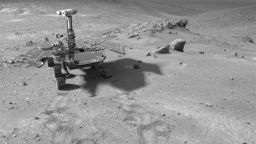 Spirit in the Columbia Hills
Spirit in the Columbia HillsThis FX or manufactured image of Spirit in the Columbia Hills was produced using "Virtual Presence in Space" technology, developed at the Jet Propulsion Laboratory (JPL). This technology combines visualization and image-processing tools with Hollywood-style special effects to create a realistic image comprised of a photorealistic model of the rover and an image taken by Spirit with its navigation camera on Sol 438 (Mar. 27, 2005). The size of the rover in the image is approximately correct and was based on the size of the rover tracks in the navigation-camera image. Since such syntheses provide viewers with a sense of their own "virtual presence," such views can be useful to mission teams in planning exploration by enhancing perspective and a sense of scale. Dan Maas created the MER model; synthetic image by Koji Kuramura, Zareh Gorjian, Mike Stetson and Eric M. De Jong.
Credit: NASA / JPL-Caltech
There may be more secrets waiting to be told in the kilobits of data gathered by the MERs that remains un-mined. "This was a big discovery that wasn't obvious," Squyres pointed out. "It does make me wonder what else is out there lurking in our data that we haven't caught yet."
Remember, through it all the rovers have been roving. There has never been a minute since Spirit and Opportunity landed that their wellbeing hasn’t been the number one priority on the mission. "We're going to continue to go back to old data, but we really do have so much work to do writing up the recent results and just continuing the mission," said Squyres, noting that he is “shoehorning” our interview in with daily flight operations. “The highest priority right now is to keep operating the vehicles.”
Most people following the mission know the mantra: Any day of operations lost on Mars is a day lost forever.
“Once data are on the ground, we have all the time to analyze,” Squyres said. “Are there other things in the data that have yet to be uncovered? Well, common sense tells you there's kinda gotta be." Ruff agreed: "The Mini-TES dataset is rich and largely untapped,”“The level of detail you can get out of these spectra especially with proper corrections is really good and there is a lot there. In fact, I think we've kind of just skimmed the surface so far.”
"Maybe there are even better gems out there,” mused Morris. “That would be great."
Another bigger, faster, smarter rover and other researchers may well finish this story. "Everybody's very excited by the fact we can send the Mars Science Laboratory (MSL) rover to a phyllosilicate site," Squyres pointed out. "And the reason everyone is exited by phyllosilicates is because phyllosilicates point to water conditions with neutral pH. Well, so do carbonates and what we've found now is carbonates."
Indeed, Spirit, once again will go into history as the first. This time, she is the first robot on Mars to send home the hard evidence of carbonates from the planet's surface. As planetary exploration goes, that's pretty great. Actually, it doesn't get any cooler in Mars exploration these days.
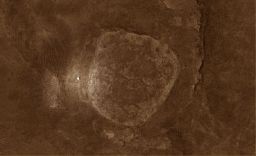 Spirit still shining at Troy
Spirit still shining at TroyIn this picture of Home Plate, taken by the HiRISE camera onboard the Mars Reconnaissance Orbiter, you can easily see the stark white figure that is Spirit to the left (west) of the geologic formation in this image. Credit: NASA / JPL-Caltech / UA / enhancement by Stuart Atkinson
Up on Mars, Spirit snoozes on. The team is looking forward to hearing a familiar 'beep' in coming months as spring warms the planet.
On the other side of Mars, Opportunity is casually cruising along again after giving the team a bit of a scare. Turns out, a "handshake," as Squyres described it, between the rover's Mini-TES and panoramic camera (Pancam) mast assembly (PMA) was lost and the PMA didn't turn. Meaning, Opportunity failed to turn her head.
While the engineers troubleshot, concern grew that a motor or actuator in the PMA might have suffered a short. Alas, the failure turned out to be with Mini-TES and not the PMA.
So, while things are not looking good for the Mini-TES, which has been completely obscured with dust since the global storm of 2007, Opportunity's neck is just fine. The rover revved up last weekend for a 60-meter drive and roved ever onward toward Endeavour Crater, as determined as ever to gather some phyllosilicates of her own.
CITATIONS
1 "Identification of Carbonate-Rich Outcrops on Mars by the Spirit Rover." Authors: Richard V. Morris, Steven W. Ruff, Ralf Gellert, Douglas W. Ming, Raymond E. Arvidson, Benton C. Clark, D. C. Golden, Kirsten Siebach, Göstar Klingelhöfer, Christian Schröder, Iris Fleischer, Albert S. Yen, Steven W. Squyres. Science, published online June 3, 2010_ DOI: 10.1126 / science.1189667.
2 "Identification of carbonate minerals in the Martian dust." Authors: J.L. Bandfield, T.D. Glotch, and Paul R. Christensen, Spectroscopic Science, v. 301, p. 1084-1087, 2003.
3 "Orbital Identification of Carbonate-Bearing Rocks on Mars." Authors: Bethany L. Ehlmann, John F. Mustard, Scott L. Murchie, Francois Poulet, Janice L. Bishop, Adrian J. Brown, Wendy M. Calvin, Roger N. Clark David J. Des Marais, Ralph E. Milliken, Leah H. Roach, Ted L. Roush, Gregg A. Swayze, James J. Wray. Science 19 December 2008: Vol. 322., no. 5909, pp. 1828 - 1832_DOI: 10.1126/science.1164759
4 "Iron mineralogy and aqueous alteration from Husband Hill through Home Plate at Gusev Crater, Mars: Results from the Mössbauer instrument on the Spirit Mars Exploration Rover." Authors. Richard V. Morris, Göstar Klingelhöfer, Christian Schröder, Iris Fleischer, Doug W. Ming, Albert S. Yen, Ralf Gellert, Raymond E. Arvidson, Daniel S. Rodionov, Larry S. Crumpler, Ben C. Clark, B.A. Cohen, T.J. McCoy, D. W. Mittlefehldt, M.E. Schmidt, P.A. de Souza, Steven W. Squyres. Journal of Geophysical Research - Planets, Vol. 113, No. E12, E12S42, Dec. 23, 2008.
5 "Search for Past Life on Mars: Possible Relic Biogenic Activity in Martian Meteorite ALH84001." Authors: David S. McKay, Everett K. Gibson, Jr., K.L. Thomas-Keprta, H. Vali, C.S. Romanek, S.J. Clemett, S.J., X.D.F. Chillier, C.R. Maechling, C.R. and R.N. Zare. Science, v. 273, p. 924-930, 1996.
 Spirit descends Husband Hill
Spirit descends Husband HillIn late November 2005, while descending Husband Hill, Spirit took this image while stopped at Seminole, one in a series of bedrock-laden terraces. It is the most detailed panorama so far of the Inner Basin, her next target destination. The rover acquired the 405 individual images that make up this 360-degree view of the surrounding terrain using five different filters on the PanCam from Sols 672 to 677 (November 23 to 28, 2005), duringthe Thanksgiving holiday weekend. This image is an approximately true-color rendering using camera's 750-, 530-, and 430-nanometer filters. Seams between individual frames have been eliminated from the sky portion of the mosaic to better simulate the vista a person standing on Mars would see. Credit: NASA / JPL / Cornell
Support our core enterprises
Your support powers our mission to explore worlds, find life, and defend Earth. You make all the difference when you make a gift. Give today!
Donate

 Explore Worlds
Explore Worlds Find Life
Find Life Defend Earth
Defend Earth



